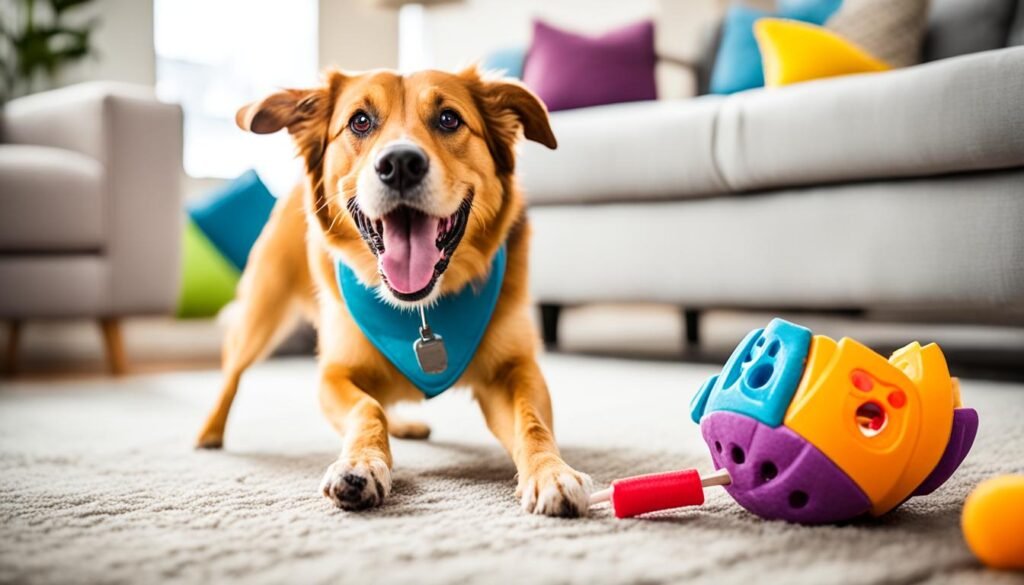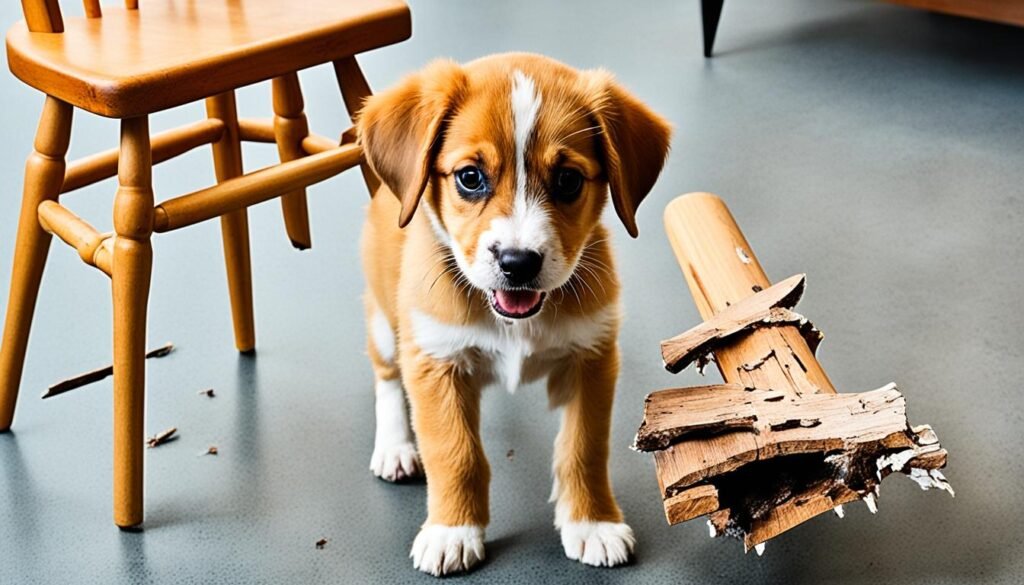As a dog owner, I’ve experienced the frustration of finding my favorite armchair or table leg chewed to shreds. It’s a common problem that can leave us feeling exasperated and at a loss for how to address it. But the truth is, with the right approach and understanding, we can stop our canine companions from turning our homes into their own personal playgrounds.
Key Takeaways
- Chewing is a natural behavior for dogs, but it can be redirected to appropriate chew toys and treats.
- Understanding the reasons behind the chewing, such as teething, boredom, or stress, is crucial to finding the right solution.
- Positive reinforcement and management strategies, like providing plenty of exercise and interactive toys, can effectively stop furniture chewing.
- Consistency and patience are key when training dogs to break the habit of chewing on furniture.
- Expert tips and techniques can help you protect your home and maintain a harmonious relationship with your furry friend.
In this article, we’ll explore expert tips and strategies to effectively stop your dog from chewing on your furniture. We’ll dive into the reasons behind this common behavior, from teething puppies to bored adult dogs, and uncover the most effective solutions to keep your home and your dog’s chewing habits in check1. Whether you’re dealing with a persistent chewing problem or want to be proactive in preventing it, this guide will equip you with the knowledge and tools to reclaim your furniture and maintain a happy, healthy relationship with your canine companion.
Understanding Why Dogs Chew Furniture
Dogs, especially puppies, often chew on furniture due to a variety of reasons. Puppy chewing can be a normal behavior as they explore their environment, play, or satisfy their teething needs2. As dogs mature, adult chewing may be a response to boredom, stress, or a lack of mental stimulation2.
Teething and Exploration in Puppies
Puppies start getting teeth around 16 weeks of age and may continue teething until they are 7 to 8 months old3. During this time, they may chew on furniture to relieve the discomfort of dog teething and to explore their surroundings2. Providing appropriate chew toys can help redirect this natural behavior and prevent destructive behavior2.
Boredom, Stress, and Lack of Stimulation in Adult Dogs
Adult dogs may continue to chew on furniture due to dog boredom, dog stress, or a lack of mental stimulation2. Breeds bred for working tasks may require more physical and mental activity to meet their needs2. Identifying the underlying causes and providing appropriate outlets, such as regular exercise, training, and interactive toys, can help reduce destructive behavior2.
| Home Remedy | Effectiveness |
|---|---|
| Apple cider vinegar | 1 out of 8 provided home remedies4 |
| Chili pepper spray | 1 out of 8 home remedies4 |
| Black pepper | 1 out of 8 home remedies4 |
| Lemon juice | 1 out of 8 home remedies4 |
| Frozen treats | 1 out of 8 home remedies4 |
| Unscented soap | 1 out of 8 home remedies4 |
The article emphasizes the importance of understanding the reasons behind a dog’s furniture chewing behavior and recommends seeking help from a professional positive dog trainer4. The process of stopping dogs from chewing furniture may take time and may require consulting with a professional4.

By addressing the underlying causes of dog chewing, such as puppy chewing, dog boredom, dog stress, and lack of mental stimulation, pet owners can effectively manage and reduce destructive behavior23.
How to stop a dog from chewing furniture
Providing Appropriate Chew Toys and Treats
To successfully stop your dog from chewing on your furniture, it’s crucial to provide them with appropriate chew toys and treats that can satisfy their natural chewing instinct5. Chewing is a natural behavior that can persist into adulthood if not addressed during the puppy stage, so introducing the right type of chew toys early on is key5.
Look for durable rubber toys, food-dispensing toys, and edible chews that can keep your dog engaged and entertained5. Chew toys like the Kong Classic and Zogoflex Tux Treat Dispensing Toy are highly recommended, as they can excite dogs and help clean their teeth and gums5. Offering a variety of chew treats can also be an effective way to redirect your dog’s chewing behavior from your furniture5.
In addition to providing appropriate chew toys and treats, using pet-safe deterrents, such as bitter sprays, can help make your furniture less appealing to your dog6. Bitter tasting sprays applied for at least three to four weeks can deter dogs from chewing on your furniture5. However, it’s important to use caution, as some dogs may still chew on objects coated with these deterrents6.
Combining these strategies of providing enrichment and using deterrents can be an effective way to stop your dog from chewing on your furniture6. Remember, a well-exercised and mentally stimulated dog is less likely to engage in destructive chewing behaviors5.

| Chew Toy | Description | Benefits |
|---|---|---|
| Kong Classic | Durable rubber toy that can be filled with treats | Provides mental stimulation and helps clean teeth |
| Zogoflex Tux Treat Dispensing Toy | Food-dispensing toy that encourages chewing and problem-solving | Keeps dogs engaged and entertained, promotes positive chewing behavior |
| Edible Chews | Natural treats like bully sticks, rawhide, or dental chews | Satisfy the chewing instinct, clean teeth, and provide a rewarding experience |
Training and Management Strategies
Alongside providing appropriate chew toys, training and management strategies can effectively stop your dog from chewing on furniture7. Positive reinforcement, where you reward your dog for chewing on approved toys, can help reinforce the desired behavior7. Redirecting your dog’s attention to appropriate chew items when they’re about to target furniture is also crucial8. Additionally, supervision and crate training can help prevent unsupervised chewing when you’re not able to directly monitor your dog7.
Positive Reinforcement and Redirection
The key to stopping destructive chewing is to redirect your dog’s natural chewing instinct to appropriate items78. By using positive reinforcement and rewarding your dog when they chew on their approved toys, you can reinforce the desired behavior7. Additionally, when you catch your dog about to chew on furniture, calmly redirect their attention to a chew toy or treat7.
Supervision and Crate Training
Closely supervising your dog when they are unsupervised is crucial to preventing destructive chewing79. Crate training can also be an effective management strategy, as it provides a safe and secure space for your dog when you’re unable to directly monitor them7. Yelling or punishing your dog for chewing is counterproductive and can damage the human-dog relationship7.
By combining positive reinforcement, redirection, supervision, and crate training, you can effectively stop your dog from chewing on your furniture and protect your home789.

Conclusion
Stopping your dog from chewing on furniture is a common challenge that requires a comprehensive approach. By understanding the underlying reasons behind this behavior, such as teething, boredom, or separation anxiety, you can implement effective strategies to curb the unwanted chewing and maintain a harmonious relationship with your furry friend10.
The key is to provide appropriate outlets for your dog’s natural chewing instincts by offering a variety of engaging chew toys and treats. Additionally, positive reinforcement training and redirection techniques can help modify the behavior and reinforce desired actions10. Furthermore, addressing any underlying medical or behavioral issues, such as separation anxiety, can contribute to a long-term solution11.
Investing in pet-friendly furniture and monitoring your dog’s activities, either through the use of pet cameras or hands-on supervision, can also go a long way in protecting your home and ensuring your dog’s safety10. By incorporating these strategies, you can successfully stop your dog from chewing on furniture and foster a stronger, more rewarding pet-owner relationship11.




